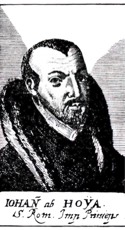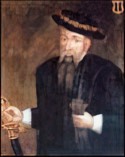Our Family History - Person Sheet
Our Family History - Person Sheet

NameMargareta Vasa (Eriksdotter)  470
470
 470
470Birth Date1 Dec 1497
Birth PlaceSweden, Uppland, Orkesta, Lindholmen
Death Date31 Dec 1536
Death PlaceEstonia, Harju Tallinn (Reval)
Burial PlaceEstonia, Harju Tallinn (Reval)
MemoS:t Olaf´s church, Reval (Tallin), Estonia (Estland)
FatherErik Vasa (Johansson) (1470-1520)
MotherCecilia Eka (Månsdotter) (1476-1522)
Spouses

Birth Dateabt 1490
Birth PlaceGermany, Hadenberg, Hoye
Death Date11 Jun 1535
Death PlaceDenmark, Fyn, Öksnebjerg
MemoKilled in the battle of Ochneberg
Burial Dateaft 11 Jun 1535
Burial PlaceDenmark
MemoDanmark, Odense, S:t Knuts kyrka
OccupationRiksråd, greve, länsherre på Viborg
FatherJoost von Hoya (ca1450-1507)
MotherErmgard von Lippe (1460-1524)
Marr Date15 Jan 1525
Marr PlaceSweden, Stockholm
Marr MemoThe Royal Palace - Tree Kronor
ChildrenJost (1525-1566)

Birth Dateabt 1485
Birth PlaceSweden, Södermanland
Death Date8 Nov 1520
Death PlaceSweden, Stockholm
MemoStockholm's blood bath
OccupationRoyal Council
Marr Date30 Mar 1516
Marr PlaceSweden, Stockholm
Marr MemoThe Royal Palace - Tree Kronor
Notes for Margareta Vasa (Eriksdotter)
Margareta Vasa was the sister of Gustav Vasa. She married Joakim Brahe on March 30, 1516 and had the children Brita and Per (known as Per Brahe d. Ä.).
Joakim was executed in the Stockholm massacre in 1520, when her father Erik Vasa was also executed. She inherited Rydbyholm from her executed father Erik Vasa.
Margareta was taken as a prisoner to Copenhagen, where she lived in prison custody in the Blue Tower. Margareta's mother, Cecilia Månsdotter, her grandmother Sigrid Banér and her aunt Kristina Gyllenstierna were also imprisoned with her. Margareta survived, but her mother and several others died of the plague
Margareta returned to Sweden in 1524 and the following year she remarried the handsome German count Johan of Hoya. With Johan she had two sons.
Johan broke off the relationship with the king in 1534 and fled to Germany. Margareta and her son Per Brahe accompanied him to Germany. After Johan's death in 1535, Margareta did not dare to return for fear that the king would harm her children.
Margareta died on 31 December 1536 in Reval (now Tallinn in Estonia) and was buried in front of the high altar in the cathedral, St. Olaf's Church.
Joakim was executed in the Stockholm massacre in 1520, when her father Erik Vasa was also executed. She inherited Rydbyholm from her executed father Erik Vasa.
Margareta was taken as a prisoner to Copenhagen, where she lived in prison custody in the Blue Tower. Margareta's mother, Cecilia Månsdotter, her grandmother Sigrid Banér and her aunt Kristina Gyllenstierna were also imprisoned with her. Margareta survived, but her mother and several others died of the plague
Margareta returned to Sweden in 1524 and the following year she remarried the handsome German count Johan of Hoya. With Johan she had two sons.
Johan broke off the relationship with the king in 1534 and fled to Germany. Margareta and her son Per Brahe accompanied him to Germany. After Johan's death in 1535, Margareta did not dare to return for fear that the king would harm her children.
Margareta died on 31 December 1536 in Reval (now Tallinn in Estonia) and was buried in front of the high altar in the cathedral, St. Olaf's Church.
Notes for Johann VII (Spouse 1)
Count Johann VII von Hoya-Brockenhuus (Hoya)
Finnish: Kreivi Juhana von Hoya, English, Old: Count Johan of Hoya, Swedish: Greve Johan af Hoya
Between Bremen and Hanover lay a small county sandwiched: Hoya (and Bruchhausen). At the beginning of the 16th century, the count in the area was named Jost I. He was married to a noble woman from a German principality located between the Weser and Teutoburg Forest, Ermgard of Lippe. She belonged to one of Germany's oldest families. Together they ruled their little principality. They had three sons before her husband Jost passed away; it happened in 1507. The boys were given the names Jost (II), Erik and Johan. At the time of the father's death, however, none of the sons were of legal age. The unfortunate circumstance paired with the fact that the county of Hoya in the years 1512-1520 was occupied land - the dukes of Braunschweig-Luneburg had at the time of the count's death taken the opportunity to invade the area - meant that the widow Ermgard had to take care of everything.
In any case, the time under foreign rule ended happily. The sons grew up and became young men with the right to call themselves counts. The eldest son Jost remained at the home castle and took over the count's burden. The two younger sons sought happiness. In other words: war. It was common for noble sons to go abroad to learn the craft of war; the time as volunteers gave the boys experiences and contacts for the future.
Brothers Erik and Johan took part in the Danish civil war that broke out shortly after the Swedish massacre. But they fought on different sides. Erik fought for King Christian II, while Johan gave his support to Duke Fredrik, future Fredrik I. For Count Johan, his participation in that war would mean more than he imagined behind his lowered visor and on his war stallion. Johan's Danish adventure ended in the summer of 1524 when he entered Swedish service. It developed into a strange work situation. The same year he took the plunge into professional life, he became engaged to his employer's sister, Margareta.
Johan av Hoya, a German count from Lübeck, who became councilor with Gustav Vasa! But Gustav Vasa could not stand his brother-in-law and had obvious cooperation problems with him. But the king used Johan of Hoya and Margareta to go to Catherine of Saxony-Lauenburg in 1529 to perform his proposal.
Johan broke with the king in 1534 and fled to Germany. Accompanying to Germany was Per Brahe d ä and his mother Margareta (who was remarried to Johan av Hoya). After Margareta's death (1536) Gustav Vasa managed to bring his now orphaned nephew Per Brahe d ä. To Sweden in 1537.
In Denmark, Johan was involved in the so-called "the count's feud". Kristian III had in 1535 gathered a considerable army here in Jutland under the leadership of Johan Rantzau, the man who crushed Sören Norby's jacks and the Göingeböndernas rally in 1525. In March, Rantzau went over to Funen and defeated a couple of months later Count Christoffer in the battle of Öksnebjerg. Here, Archbishop Gustav Trolle was mortally wounded, while Count Johan of Hoya fell.
Finnish: Kreivi Juhana von Hoya, English, Old: Count Johan of Hoya, Swedish: Greve Johan af Hoya
Between Bremen and Hanover lay a small county sandwiched: Hoya (and Bruchhausen). At the beginning of the 16th century, the count in the area was named Jost I. He was married to a noble woman from a German principality located between the Weser and Teutoburg Forest, Ermgard of Lippe. She belonged to one of Germany's oldest families. Together they ruled their little principality. They had three sons before her husband Jost passed away; it happened in 1507. The boys were given the names Jost (II), Erik and Johan. At the time of the father's death, however, none of the sons were of legal age. The unfortunate circumstance paired with the fact that the county of Hoya in the years 1512-1520 was occupied land - the dukes of Braunschweig-Luneburg had at the time of the count's death taken the opportunity to invade the area - meant that the widow Ermgard had to take care of everything.
In any case, the time under foreign rule ended happily. The sons grew up and became young men with the right to call themselves counts. The eldest son Jost remained at the home castle and took over the count's burden. The two younger sons sought happiness. In other words: war. It was common for noble sons to go abroad to learn the craft of war; the time as volunteers gave the boys experiences and contacts for the future.
Brothers Erik and Johan took part in the Danish civil war that broke out shortly after the Swedish massacre. But they fought on different sides. Erik fought for King Christian II, while Johan gave his support to Duke Fredrik, future Fredrik I. For Count Johan, his participation in that war would mean more than he imagined behind his lowered visor and on his war stallion. Johan's Danish adventure ended in the summer of 1524 when he entered Swedish service. It developed into a strange work situation. The same year he took the plunge into professional life, he became engaged to his employer's sister, Margareta.
Johan av Hoya, a German count from Lübeck, who became councilor with Gustav Vasa! But Gustav Vasa could not stand his brother-in-law and had obvious cooperation problems with him. But the king used Johan of Hoya and Margareta to go to Catherine of Saxony-Lauenburg in 1529 to perform his proposal.
Johan broke with the king in 1534 and fled to Germany. Accompanying to Germany was Per Brahe d ä and his mother Margareta (who was remarried to Johan av Hoya). After Margareta's death (1536) Gustav Vasa managed to bring his now orphaned nephew Per Brahe d ä. To Sweden in 1537.
In Denmark, Johan was involved in the so-called "the count's feud". Kristian III had in 1535 gathered a considerable army here in Jutland under the leadership of Johan Rantzau, the man who crushed Sören Norby's jacks and the Göingeböndernas rally in 1525. In March, Rantzau went over to Funen and defeated a couple of months later Count Christoffer in the battle of Öksnebjerg. Here, Archbishop Gustav Trolle was mortally wounded, while Count Johan of Hoya fell.
